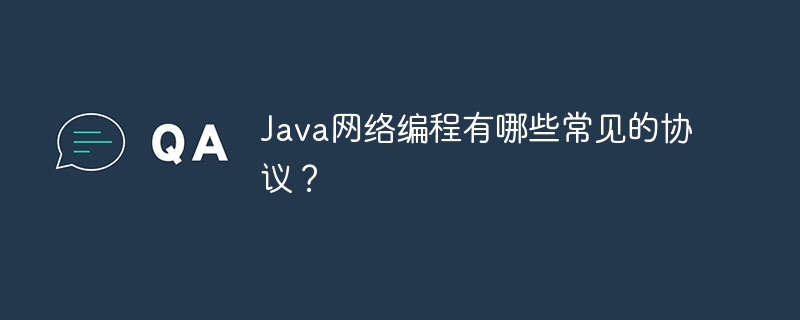Home >Java >javaTutorial >What are the common protocols for Java network programming?
Java Commonly used protocols in network programming include: TCP/IP: used for reliable data transmission and connection management. HTTP: Used for web data transfer. HTTPS: A secure version of HTTP that uses encryption to transmit data. UDP: For fast but unstable data transfer. JDBC: used to interact with relational databases.

Common protocols in Java network programming
Network programming is an important part of Java development, which enables applications to Communicate over the network. In Java network programming, there are several common protocols used to implement data transmission and processing.
1. TCP/IP
TCP/IP (Transmission Control Protocol/Internet Protocol) is a protocol stack used for reliable transmission of data on the network. It provides streaming data transfer and connection management capabilities to ensure data reaches its destination in the correct order.
2. HTTP
HTTP (Hypertext Transfer Protocol) is a protocol used to transfer data on the Web. It is used to request and respond to web pages, images, and other files.
3. HTTPS
HTTPS is a secure version of HTTP that uses TLS/SSL encryption to transmit data. It is often used to protect sensitive information such as passwords and credit card numbers.
4. UDP
UDP (User Datagram Protocol) is a connectionless protocol used for unstable transmission of data. It is more suitable for real-time applications such as video streaming and gaming.
5. JDBC
JDBC (Java Database Connectivity) is a Java API for interacting with relational databases. It allows Java programs to connect to the database, perform queries and update data.
Practical case: Use TCP/IP to create a simple chat server-client
The following is a program to use TCP/IP to create a simple chat server-client Example:
Server.java
import java.io.*;
import java.net.*;
public class Server {
public static void main(String[] args) throws IOException {
// 创建服务器套接字并监听端口
ServerSocket serverSocket = new ServerSocket(1234);
// 无限循环,等待客户端连接
while (true) {
// 接受客户端连接
Socket clientSocket = serverSocket.accept();
// 创建输入流读取客户端消息
BufferedReader in = new BufferedReader(new InputStreamReader(clientSocket.getInputStream()));
// 创建输出流发送消息到客户端
PrintWriter out = new PrintWriter(clientSocket.getOutputStream(), true);
// 读取客户端消息并打印到控制台
String message = in.readLine();
System.out.println("Received message: " + message);
// 向客户端发送应答消息
out.println("Hello from server!");
// 关闭套接字和流
clientSocket.close();
in.close();
out.close();
}
}
}Client.java
import java.io.*;
import java.net.*;
public class Client {
public static void main(String[] args) throws IOException {
// 创建客户端套接字并连接到服务器
Socket clientSocket = new Socket("localhost", 1234);
// 创建输出流发送消息到服务器
PrintWriter out = new PrintWriter(clientSocket.getOutputStream(), true);
// 创建输入流读取服务器消息
BufferedReader in = new BufferedReader(new InputStreamReader(clientSocket.getInputStream()));
// 向服务器发送消息
out.println("Hello from client!");
// 读取服务器应答消息并打印到控制台
String message = in.readLine();
System.out.println("Received message: " + message);
// 关闭套接字和流
clientSocket.close();
in.close();
out.close();
}
}The above is the detailed content of What are the common protocols for Java network programming?. For more information, please follow other related articles on the PHP Chinese website!